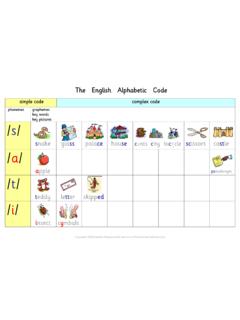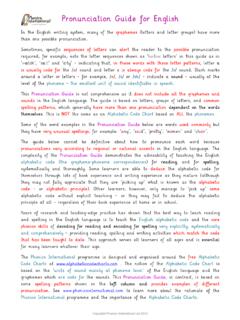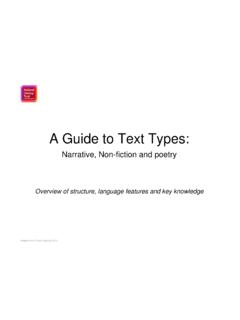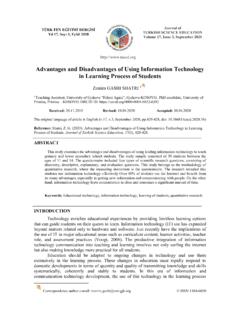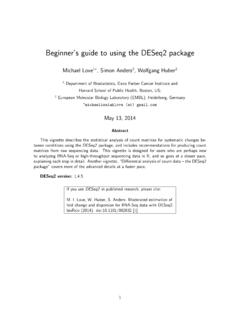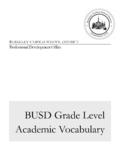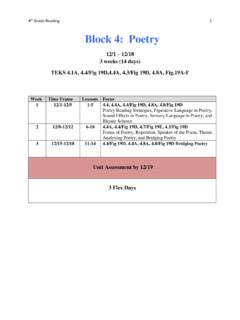Transcription of How to set up and use your core ... - Phonics International
1 How to set up and use your core and essential Phonics International resources Links to important guidance and information documents are provided throughout in yellow bands below. Most of the links are from the Free Resources page of . In a Alphabetic Code Charts: The starting point for using the Phonics International programme is to read the document In a (link above) and then select your preferred Alphabetic Code Charts for teaching and learning. There are many versions of the charts of various sizes for different purposes and for different interest groups which are free to download at the charts website.
2 Examples of the first section of the Giant charts: You need to decide on a version of the Giant Alphabetic Code Charts for your main display walls preferably display one in every classroom as the chart can support writing activities in other subjects in the wider curriculum use routinely as a spelling reference chart. You might decide on different charts in different classrooms or use a colour-coded one in a smaller size alongside a plainer version on the main display wall. If possible, you may want to enlarge each of the ten A4 sheets of the Giant Alphabetic Code Chart to A3 and then you can display the chart in two parallel columns.
3 The potential of Alphabetic Code Charts and the Two-Pronged Approach to Synthetic Phonics Teaching: Systematic and Incidental You can find plasticised ready-made giant pull-up and hang down portable charts in our online shop to purchase for classrooms if you prefer or for special occasions like presenting information for a parents event. A4 mini tabletop charts are also available to buy. About the pull-up chart: The Phonics Folder in the School s Book-bag Routine: These are just examples not Phonics International products.
4 Set up each learner (from infants to adults) with an easy-to-use Phonics folder and a Phonics exercise book with lines. Keep all the paper-based core resources that belong to the learner in his or her Phonics folder which can then be used routinely for personal revisit and review . Use the Phonics exercise book as a working notebook for any additional Phonics work, spelling, dictation and handwriting activities as required. The exercise book can also be used for basic skills in the wider curriculum. Setting-up, and use of, the essential Phonics Folder for every learner Copyright Debbie Hepplewhite and Phonics International Limited 2007 - 2019 Variations of Mini Alphabetic Code Charts: Select a mini Alphabetic Code Chart for each learner s Phonics folder.
5 You may want to include a tracking chart to show which letter/s-sound correspondences have been systematically introduced to date as well as an informative mini chart which includes word examples for all the spelling alternatives. See the full guidance document for setting up the learners Phonics folders link above. You could also include a mini alphabetic code chart direct in your school s literacy policy and/or school s brochure to make it clear which letter/s-sound correspondences are formally introduced within your school s reading and spelling programme.
6 Thus it is both an information and accountability tool. Hard copy A4 Tabletop Alphabetic Code Chart: Ready-made mini Tabletop charts are available to buy in our online shop. You can use Tabletop charts in the class generally to support all lessons involving writing not just the discrete Phonics sessions. Constant accessibility to overview Alphabetic Code Charts also enable incidental Phonics teaching and self-teaching. Online shop: Reflecting on the Teaching and Learning Cycle - Click HERE Debbie Hepplewhite s suggestions for effective and supportive Phonics provision and practice (audit/check list) Copyright Debbie Hepplewhite and Phonics International Limited 2007 - 2019 Debbie Hepplewhite s Model of the three Phonics core skills and their sub-skills Three Posters for Phonics Routines Reading, Spelling, Handwriting Guidance for the Phonics hand routines.
7 Easy-to-follow guidance for staff in schools and parents describes the Phonics hand routines for the three core skills and their sub-skills link above. It is really important that learners are provided with the same Phonics routines especially when more than one adult models for them and supports the learning. As well as providing whole-school consistency and continuity, it ensures that learners with challenges or learning difficulties receive consistent teaching. For further professional development, see the Guidance for Phonics Routines link below which repeats the same Phonics routines for the core skills and their sub-skills but with additional advice for the Phonics routines.
8 Guidance for Phonics Routines Revisit and review: Use flash cards for younger learners, and Say the Sounds Posters for both younger and older learners: The Say the Sounds Posters are invaluable in many ways use for engaging learners in their own learning and assessment and use for periodic formal assessment. Guide learners to tick in pencil what they think they know well and to circle any graphemes they are not sure of. The teacher does the same but in a coloured pen. Also - enlarge to A3 to make wall display posters for supporting ad hoc (incidental) practice and early writing.
9 Sometimes project large scale onto plain walls, screens or whiteboards for whole class revisit and review . The Phonics International programme is most effectively delivered in a routine teaching and learning cycle (see flow diagram above). This means that each lesson begins with a quick-fire revision session which is commonly referred to as revisit and review . With younger learners, flash cards showing letters and letter groups are used routinely for this part of the lesson (several different sets provided in Phonics International and in the Early Years Starter Package).
10 A really important activity for both younger and older learners is: See the graphemes, and say the sounds and Hear the sounds, select and/or write the graphemes . Three Say the Sounds Posters are provided in every unit (of 12 units of systematic resources) throughout the Phonics International programme. This is a very effective resource for constant revision of the alphabetic code. Revisit and review can also include learners re-reading their previous word-level and text-level work, as required, to become familiar with new words and to build up fluency and automaticity when reading texts.
